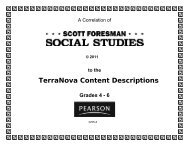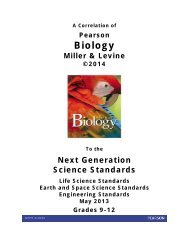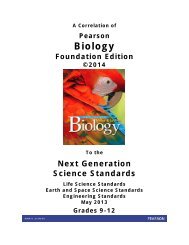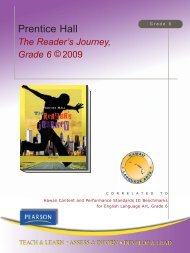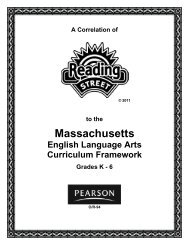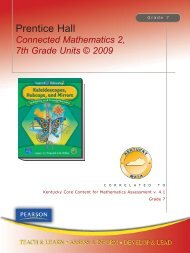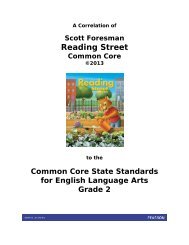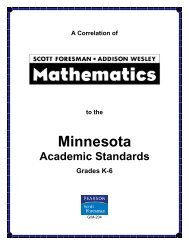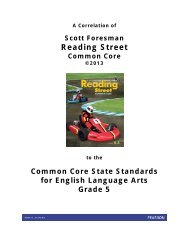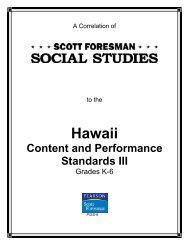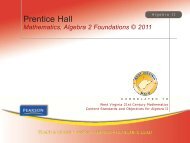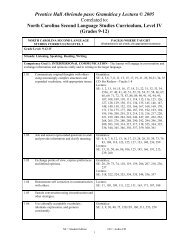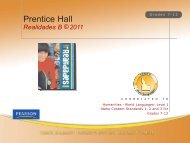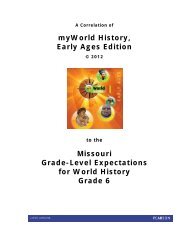Scott Foresman Reading Street - Pearson
Scott Foresman Reading Street - Pearson
Scott Foresman Reading Street - Pearson
Create successful ePaper yourself
Turn your PDF publications into a flip-book with our unique Google optimized e-Paper software.
<strong>Scott</strong> <strong>Foresman</strong> <strong>Reading</strong> <strong>Street</strong> © 2008to theCommon Core Georgia Performance Standards (CCGPS)Grade 5Common Core GeorgiaPerformance Standards – Grade 5b. Compare and contrast the varieties ofEnglish (e.g., dialects, registers) used instories, dramas, or poems.Vocabulary Acquisition and UseELACC5L4: Determine or clarify themeaning of unknown and multiple-meaningwords and phrases based on grade 5reading and content, choosing flexibly froma range of strategies.a. Use context (e.g., cause/effectrelationships and comparisons in text) as aclue to the meaning of a word or phrase.b. Use common, grade-appropriate Greekand Latin affixes and roots as clues to themeaning of a word (e.g., photograph,photosynthesis).<strong>Scott</strong> <strong>Foresman</strong><strong>Reading</strong> <strong>Street</strong> © 2008TE 2: 142l–142m; 3: 363aIn the Fluency sections of the program andin Listening and Speaking sections,students develop oral language skills basedon their interpretations of the languageused in stories, drama, and poems.The program also investigates the uses ofidioms, slang, and jargon. See, forexample, TE 4: 449; 6: 733.The program offers numerous instructionalopportunities to help students determinethe meanings of words through vocabularyand affixation activities. See the followingrepresentative pages:SE: 114–115, 264–265, 562–563TE 1: 114–115, 133c; 2: 164b; 3: 264–265, 275, 278, 348b, DI•5; 4: 414b, 460b;5: 514b, 562–563, 581cThe program offers numerous instructionalopportunities to help students determinethe meanings of unfamiliar and multiplemeaningwords through vocabulary andaffixation activities. See the followingrepresentative pages:SE: 210–211, 414–415, 460–461, 584–585, 702–703TE 2: 210–211, 219, 229c; 3: 331, DI•5;4: 414–415, 425, 435c, 457c, 460–461,473, 483c, DI•15, DI•25, DI•35; 5: 571,584–585, 595, 603c, DI•25, DI•35; 6:702–703, 709, 725c, 737, 741, DI•35SE: 144–145, 188–189, 290–291, 366–367, 514–515, 606–607TE 2: 144–145, 155, 161c, 188–189, 195,207c; 3: 290–291, 297, 305, 315c, 366–367, 373, 383c; 5: 514–515, 527, 581i–581j, 603i–603j, 606–607, 625c, DI•5The program’s Vocabulary strandincorporates lessons in affixation and wordsrelated by base or root. Lessons areincluded for common base words and Latinroots and Greek word parts as well asprefixes and suffixes and their meanings.SE = Student Edition41TE = Teacher’s Edition



